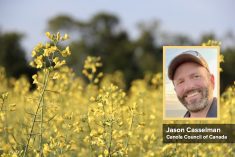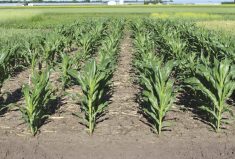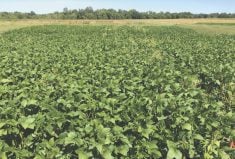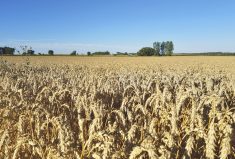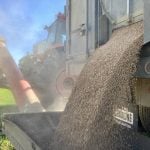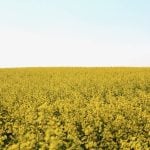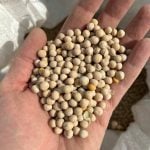The quickest path from Regina, Sask., to Steve Nelson’s farm at Birsay is to cross Lake Diefenbaker on the Riverhurst Ferry. The flat-deck ferry travels on the hour, carrying vehicles across the two-kilometre expanse of water, cutting highway travel time by at least an hour, maybe two. As a bonus, the experience gets travellers up close and personal with the giant reservoir that has never lived up to its potential.
In 1967, when the Gardiner Dam backed up the South Saskatchewan River to create the 200-km-long Lake Diefenbaker in the middle of Saskatchewan, the plan was to irrigate 500,000 parched acres. To this day, the giant T-shaped lake — named after Saskatchewan politician and Canada’s 13th Prime Minister, John George Diefenbaker — irrigates only 100,000 to 150,000 acres. “The Dief” is, one might say, an untapped resource, a ’60s-era feat of engineering stuck in vaporization mode. (It is said the lake loses more water to evaporation each year than it gives up for crop watering.)
Meanwhile, Regina has plans for three new canola-processing facilities. The Cargill plant will have capacity to crush up to one million tonnes per year. The AGT and Federated Co-op joint operation could take another million. Viterra could take up to 2.5 million. And over at Yorkton, Richardson is increasing its processing capacity by another million tonnes. Without a corresponding increase in production, many long-term export customers will do without while Canada processes more of its 20-million-tonne supply here at home. If the goal is to satisfy both domestic processors and loyal export customers, the Prairies will have to grow more canola.
Read Also
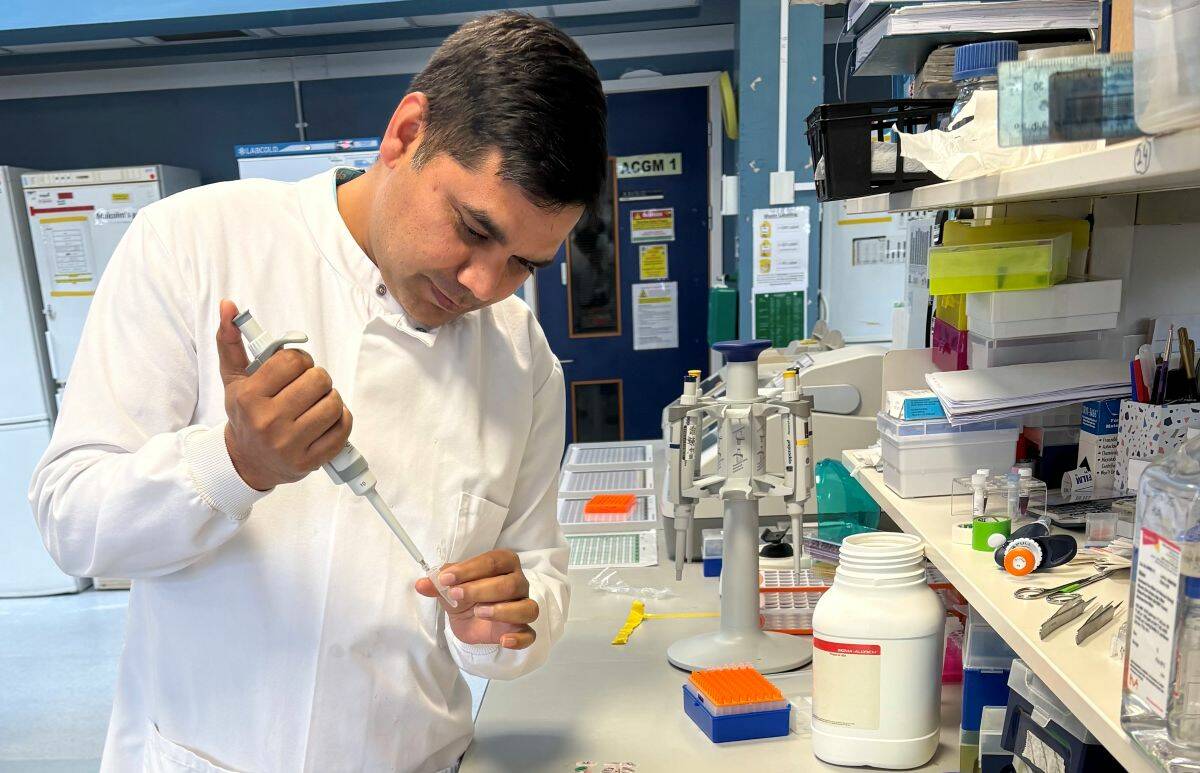
Sensing the soil: Root cell research finds ‘stress hormone’
Research into how root cells react to soil stressors could help plants better adapt to changes in their climate.
Solution: more water
Irrigation is one way to increase productivity. The Nelson family is doing its part. Steve Nelson farms with his father, Rod, and brother, Scott, within the Luck Lake Irrigation District, one of nine tapping into Lake Diefenbaker. They added irrigation pivots to 12 quarter sections in 2022, bringing the farm up to 25 quarters, or about 3,250 acres, of irrigated land. (The circle shape of the pivot covers 125-135 acres within each 160-acre quarter.)

The Nelsons spent about $1,000 to $1,200 per acre for the pivots alone. Each is a quarter-mile-long metal structure of piping, A-frame supports and wheels with electric motors. This silver snake slowly rotates around a central hub that supplies water to the nozzles and power to the wheels. The underground 12″-diameter piping and three-phase power, which extend a quarter-mile from field edge to central hub, add to the cost. One fully functioning pivot is $300,000. And that’s assuming the field has all necessary water and power available at the field edge.
As part of their 2022 project, the Nelsons had to lay three miles of 18″ and 16″ pipe and the corresponding three-phase power to reach five of their 12 target fields. That was another $1 million.
Then there are the ongoing costs. The Luck Lake Irrigation District pays up to $200,000 per month in peak season to run the pumping station, perched on the shore of Lake Diefenbaker, that keeps the whole network pressurized. The district passes that along to its farmer members through connection fees and water rates. The Nelsons paid a one-time connection fee of $20,000 to $25,000 per quarter and pay an annual bill based on each acre-foot of water applied. Steve Nelson estimates their total water invoice for 2022 at $70 to $80 per acre.
But it boosts yields
Higher yields provide the return on investment.
The Nelsons produce hybrid seed canola, yellow peas, marrowfat peas, edible beans, flax, wheat, oats, barley and corn on irrigated land. Barley and corn are ensiled for cattle feed. Nelson says barley yields up to 15 tonnes per acre, chopped, and corn up to 25 tonnes.
In the neighbourhood, wheat without irrigation in 2022 yielded 20-25 bu./ac., while wheat with irrigation yielded over 100 — which is typical, Nelson says. Irrigated canola yields in 2022 were down “because the summer was so hot for so long,” he says. Irrigated canola yielded 50-60 bu./ac., while some neighbours without irrigation had canola yields as low as five, he says. For the increase in wheat and canola yield, irrigated fields usually get double the fertilizer rates, a higher seeding rate, and at least one application of fungicide.
Saskatchewan Crop Insurance Corporation has yield data for all risk zones. Risk zone 12, which encompasses 12 municipalities east of Outlook, and risk zone 13, which includes the Nelson farm at Birsay, have the most irrigated land. SCIC’s canola yield data for zones 12 and 13 averaged 39 bu./ac. for irrigated land and 18 bu./ac. for non-irrigated dryland in 2021 and 2022. Yields in 2020 were better, with an average of close to 60 bu./ac. for irrigated canola and around 35 bu./ac. for dryland.
With these yields, “banks can’t give out the money fast enough” for irrigation projects, Nelson says. Yet, growth in irrigation is slow.
“We have been irrigating in Saskatchewan for 100 years, but we’re still underutilizing our water resource,” says Laurie Tollefson, an irrigation scientist who worked at Canada-Saskatchewan Irrigation Diversification Centre at the town of Outlook.
Saskatchewan and Canada have a $4 billion plan to increase utilization. The 10-year plan, announced in 2020, will upgrade and build water delivery canals west, north and southeast of Lake Diefenbaker. The target is to supply water to irrigate another 500,000 acres.
Saskatchewan and the federal government also had an irrigation infrastructure-funding program through the Canadian Agricultural Partnership (CAP). Applicants such as irrigation districts, could get funding for infrastructure to pipe water to the edge of fields. (Money was not available for in-field infrastructure, including the pivots). This first round of funding closed and there is no word yet of a renewal.
The province has its own goal to see pivots on 85,000 new acres by 2030. Patrick Boyle is the spokesperson for Saskatchewan’s Water Security Agency, which oversees the provincial government’s water-management responsibilities. Boyle says over 34,000 acres of irrigation have been developed since 2020, “the largest growth since the early 1980s.”
Challenges
Irrigation projects can get sunk so easily. The first challenge is water supply. Regulations require a minimum outflow from Lake Diefenbaker to keep the South Saskatchewan River servicing all of its downstream cities, towns and natural habitats.
Boyle says the Water Security Agency reviewed 88 years of flow data and found that with no change in operating, nearly 900,000 acre-feet of water per year is available for irrigation. Lake Diefenbaker has a total volume of 7.4 million acre-feet. If the 500,000-acre plan is fully realized, irrigators will use less than the 900,000 acre-feet, he says, adding, “more analysis and study will be done as the project progresses.”
Second is suitability of the land. “An ideal parcel of land is well drained, has medium soil textures, and has no underlying salinity concerns,” Boyle says. For land deemed suitable, the province issues a certificate that allows the landowner to apply for water rights from an irrigation district or from the Water Security Agency.

Nelson, who had land assessed and approved before their 2022 project could proceed, says “the province wants to make sure the land is worth irrigating.”
Third is environmental and social risk assessment. In February 2021, Saskatchewan’s Federation of Sovereign Indigenous Nations, which represents 74 First Nations in the province, issued a news release calling for consultation on the Lake Diefenbaker project.
“Irrigation projects have the potential to have widespread and devastating impacts on soils, water availability and quality, ecosystem health and wildlife,” the release stated. It included a quote from Prince Albert Grand Council Chief Brian Hardlotte, making specific reference to the Saskatchewan River delta. “The delta supports important biodiversity and is a vital ecosystem for First Nations. Analysis of how the irrigation project may further impact this delta needs to be undertaken.”
Peter Leavitt says the Lake Diefenbaker project is political as well as agricultural. The professor and Canada Research Chair in Environmental Change and Society at the University of Regina says the Impact Assessment Agency of Canada will review at least part, and perhaps all, of the $4 billion federal-provincial project.
Leavitt says Lake Diefenbaker has become part of the natural habitat. “The main thing is that more water on the landscape means more runoff, which means transport of nutrient and chemical off the land and into the water,” he says. “I’m not opposed to more irrigation as long as it’s done right.”
Finally, irrigation is expensive. As noted, it requires canals, pipelines, pumps and power to get water to field edges — costs funded through government programs and irrigation districts. Farmers then spend $300,000 or so per quarter section to set up their own infrastructure. “There is some perception that irrigation projects spend a lot of money to benefit only a few farmers,” Tollefson says, “but farmers supply the processing plants that provide a lot of jobs and opportunities in Saskatchewan.”
How much more canola?
Tollefson grew up near the town of Mossbank in the semi-arid soils of southern Saskatchewan. “In those days, no one dreamed of canola in the brown soil zone,” he says. Canola in that region was not seen as worthy of irrigation because it could not tolerate the heat of a southern Saskatchewan summer, he says.
“Now canola is an established crop in irrigation, with high-yielding hybrids proven to work well in irrigation in Saskatchewan,” Tollefson says, predicting “canola is going to be a big player under irrigation going forward.”
Research continues to look at ways to improve water-use efficiency for irrigation in general, and improve the environmental and economic sustainability of irrigated canola. SaskCanola funds a few irrigation projects, including one by Agriculture and Agri-Food Canada (AAFC) research scientist Sally Vail to address yield stability drivers of canola in a changing climate, comparing dryland and irrigated sites. Erin Karppinen and Evan Derdall, research scientists with Agriculture and Agri-Food Canada at the Canada-Saskatchewan Irrigation Diversification Centre, have ongoing projects on management practices to increase yield and oil productivity for irrigated canola, and on the effect of seeding date on irrigation requirements and water use efficiency for canola.
Karppinen says research at Outlook has pushed irrigated canola yield to over 70 bu./ac. This is with more fertilizer, fungicide applications and about 15 inches of total in-season water. Whatever water isn’t supplied through rainfall is topped up through irrigation.
Derdall, an irrigation and drainage engineer, says irrigation technology has already come a long way to improve water use efficiency. Flood irrigation, no longer a common practice in Saskatchewan, has water use efficiency of only 30 to 40 per cent because most water runs off, evaporates or seeps through the root zone, unused.
Irrigation then went to pivots with “high-impact sprinklers,” but these required more pumping energy to maintain 35-40 psi of water pressure, Derdall says. These sprinklers also produced a fine mist prone to wind drift and evaporation. Now pivots have drop nozzles — nozzles at the end of dangling hoses — bringing water closer to the crop, reducing wind loss and evaporation. These drop nozzles require pressure of only 15-20 psi, which is a lot more energy efficient. With soil moisture sensors to manage irrigation scheduling and limit excess watering, water use efficiency is now 90 per cent, or more, Derdall says, and the risk of runoff and leaching, which carry fertilizer and pesticides back to rivers and lakes, is very low. “Irrigation has seen big improvement over the past 20 years,” he says.

But not the whole solution
That’s the good news. The downside, from a canola supply perspective, is scale. Half a million new acres of irrigation represent only one per cent of Saskatchewan’s cropland. Based on a one-in-four or one-in-three crop rotation, these new irrigated acres will include 125,000 to 167,000 acres of canola each year. That’s but a small fraction of the 12 million acres of canola the province averages in a given year. Even with an irrigation-powered one-tonne-per-acre increase in yield (which is quite a bit more than current Saskatchewan crop insurance data show), the increase in canola production would be 125,000 to 167,000 tonnes. The Regina processing plants, once built and running, will take up to 4.5 million tonnes per year. Clearly, this irrigation project is not the complete answer.
However, canola will not be the only crop to benefit. Farmers with irrigation in southern Alberta, Canada’s largest irrigation area, grow a diverse rotation of crops, including edible beans, potatoes, corn, sugar beets, hybrid seed canola and dozens of other oilseed, pulse, cereal, forage and specialty crops. Alberta towns of Taber and Bow Island, for example, have processing facilities and jobs sprouting from this diversity and productivity. Lake Diefenbaker could water such agricultural diversification in Saskatchewan.
Laurie Tollefson has advised on irrigation projects in Afghanistan, China, Egypt and Iran. “I’ve worked in places that were as dry as a bone,” he says. “We have a supply of water here and we’re not using it. More irrigation absolutely has to happen. It’s going to get drier and hotter, and we should be ready.”



